Alliums add a unique flair to gardens, showcasing their stunning globe-like blooms in various sizes and colors. Easy to grow and incredibly versatile, these striking plants bring a delightful touch to any outdoor space. Whether in perennial borders, vegetable gardens, or containers, the bold presence of alliums is bound to brighten up your landscape.
Alliums in Container Gardens

Container gardens are a fantastic way to showcase alliums. These beautiful flowers bring a pop of color and unique shapes to any space. In the image, you can see a lovely arrangement of alliums in a large terracotta pot. The mix of white, pink, and purple blooms creates a cheerful display that draws the eye.
Alliums are perfect for container gardening because they thrive in well-drained soil and can adapt to various light conditions. The tall stems and round flower heads add height and interest, making them a great choice for porches or patios. Pairing them with other plants, like the lush green grass in smaller pots nearby, can enhance their beauty.
When planting alliums in containers, ensure they have enough space to grow. A larger pot allows for better root development and more vibrant blooms. Regular watering and occasional fertilizing will keep them healthy and thriving throughout the season. Enjoy the delightful sight of these stunning flowers as they bloom and brighten your outdoor space!
Companion Planting with Alliums
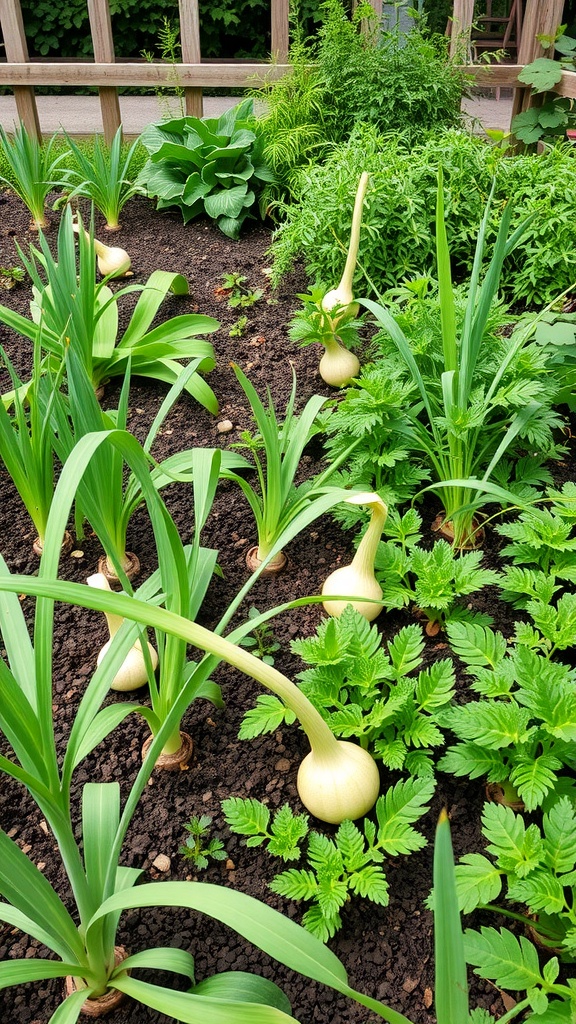
Alliums, like onions and garlic, are fantastic companions in the garden. In the image, you can see a vibrant mix of alliums alongside other plants. This combination not only looks great but also benefits the garden ecosystem.
Planting alliums with carrots, for instance, can help deter pests. The strong scent of alliums confuses insects that might otherwise target your carrots. This natural pest control is a win-win for gardeners.
Another great pairing is with leafy greens. Alliums can provide a bit of shade, helping to keep these plants cool during hot days. Plus, they can enhance the flavor of nearby greens, making your harvest even more delicious.
Incorporating alliums into your garden layout can also improve soil health. Their roots help aerate the soil, promoting better growth for neighboring plants. So, if you’re planning your garden, think about adding some alliums for a healthier, more productive space!
Alliums as Focal Points in Landscape Design
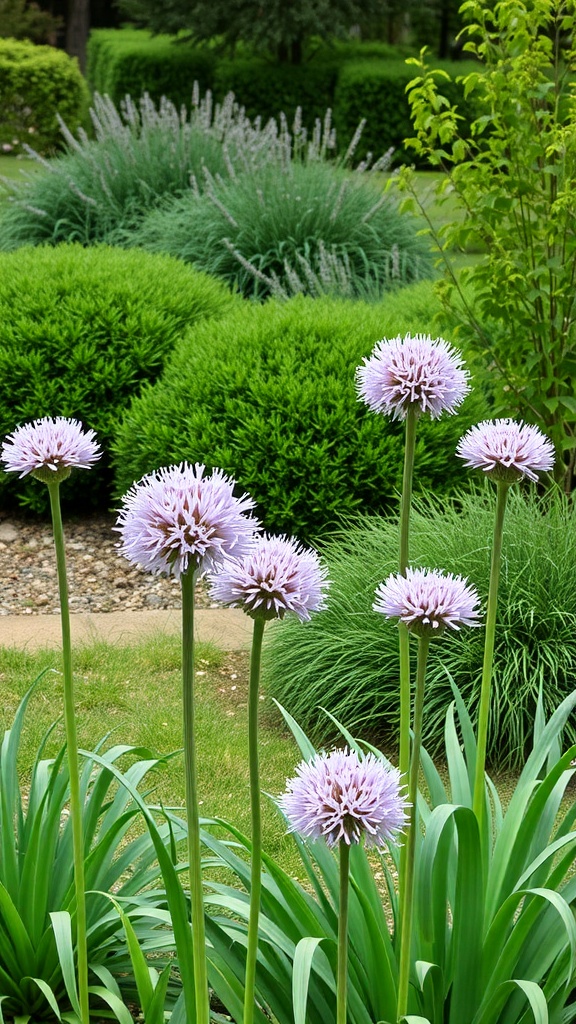
Alliums are a fantastic choice for adding height and drama to your garden. In the image, you can see tall allium flowers standing proudly above lush green foliage. Their unique round blooms create a striking visual contrast against the backdrop of rounded bushes and soft grasses.
These flowers not only catch the eye but also serve as great conversation starters. Their vibrant purple hues can brighten up any garden space. When placed strategically, alliums can guide the viewer’s gaze through the landscape, making them perfect focal points.
Incorporating alliums into your garden design can enhance the overall aesthetic. They pair well with various plants, creating a layered look that feels both natural and intentional. Whether in clusters or as standalone specimens, alliums can truly elevate your outdoor space.
Mixing Alliums with Perennials
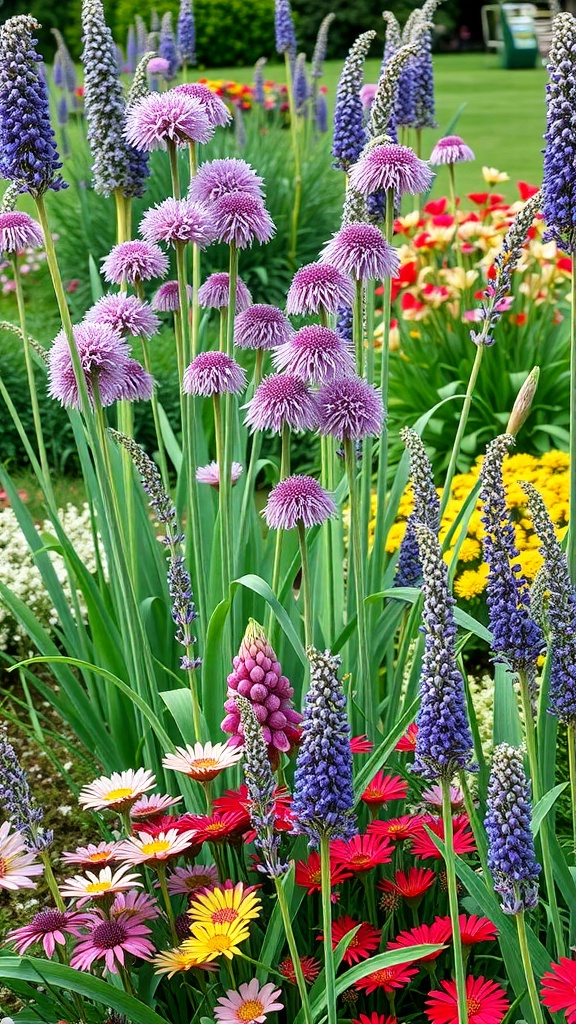
Alliums bring a unique charm to any garden. Their round, fluffy blooms add a playful touch that pairs beautifully with perennials. In the image, you can see a delightful mix of purple alliums standing tall among colorful daisies and vibrant red flowers. This combination creates a lively scene that draws the eye.
When planting alliums with perennials, consider their height and bloom time. Taller alliums can serve as a backdrop for shorter flowers, creating layers in your garden. The purple hues of the alliums contrast nicely with the bright colors of the daisies and other blooms, making the garden feel full of life.
Mixing different flower types not only enhances visual interest but also supports local pollinators. Bees and butterflies are often attracted to alliums, which can help your other flowers thrive. This blend of colors and shapes makes for a stunning display that changes with the seasons.
Seasonal Allium Blooms
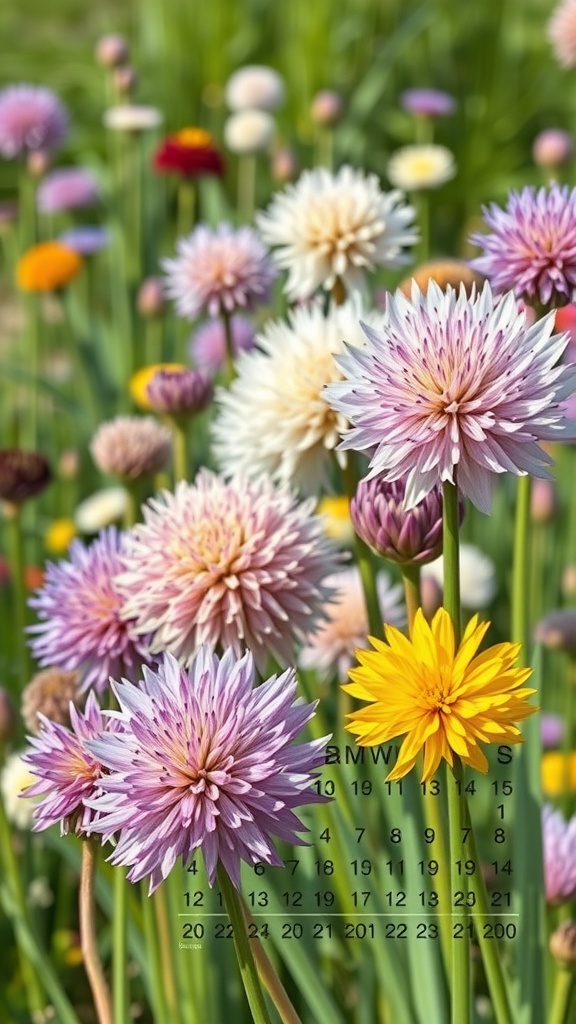
Alliums bring a burst of color and charm to gardens in spring and summer. Their unique spherical blooms stand tall, creating a stunning visual impact. In the image, you can see a delightful mix of allium varieties, showcasing shades of purple, white, and even a bright yellow. Each flower adds its own flair, making the garden feel lively and inviting.
These blooms are not just pretty; they attract pollinators like bees and butterflies, adding life to your outdoor space. Planting alliums in clusters can create a beautiful focal point. They thrive in well-drained soil and prefer sunny spots, making them easy to care for.
As the seasons change, these flowers transition gracefully, often lasting for weeks. Their long stems and sturdy nature mean they can withstand wind and rain, keeping your garden looking vibrant. Whether in a formal garden or a casual backyard, alliums are a fantastic choice for seasonal blooms.
Creating a Colorful Allium Border
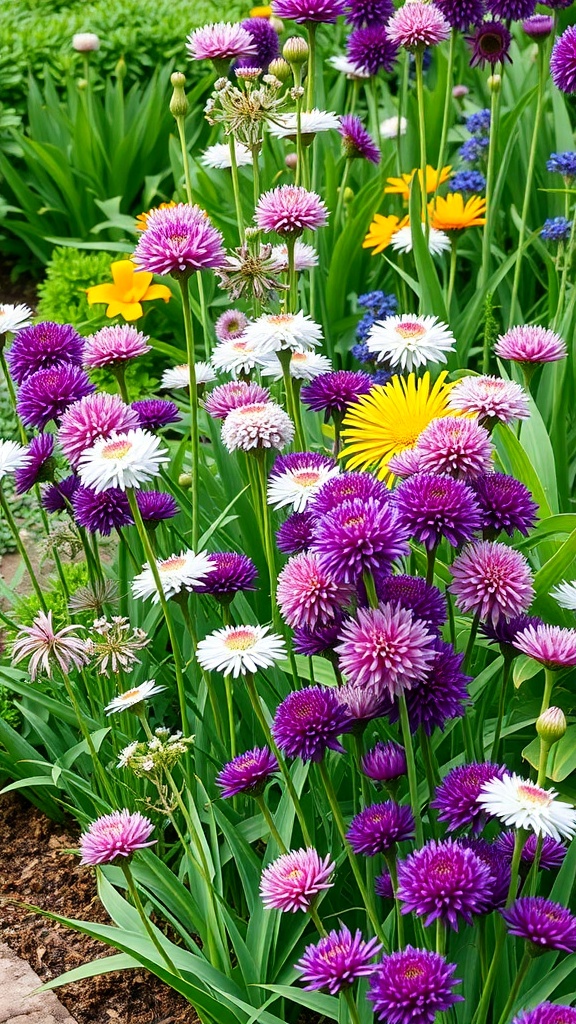
Alliums are a fantastic choice for adding a splash of color to your garden. Their unique spherical blooms can create a striking border that draws the eye. In the image, you can see a vibrant mix of purple and white alliums, surrounded by cheerful yellow and blue flowers. This combination brings life and energy to any outdoor space.
When planning your allium border, think about layering different heights. Taller alliums can stand proudly at the back, while shorter flowers can fill in the front. This layering creates depth and visual interest. The mix of colors in the image shows how well alliums pair with other blooms, making for a lively garden scene.
Don’t forget about the foliage! The green leaves of alliums complement the colorful flowers beautifully. Consider planting some low-growing ground covers to fill in any gaps. This not only enhances the look but also helps with weed control.
Overall, creating a colorful allium border is a fun and rewarding project. With a little planning, you can enjoy a stunning display of blooms that will brighten your garden throughout the growing season.
Attracting Pollinators with Alliums
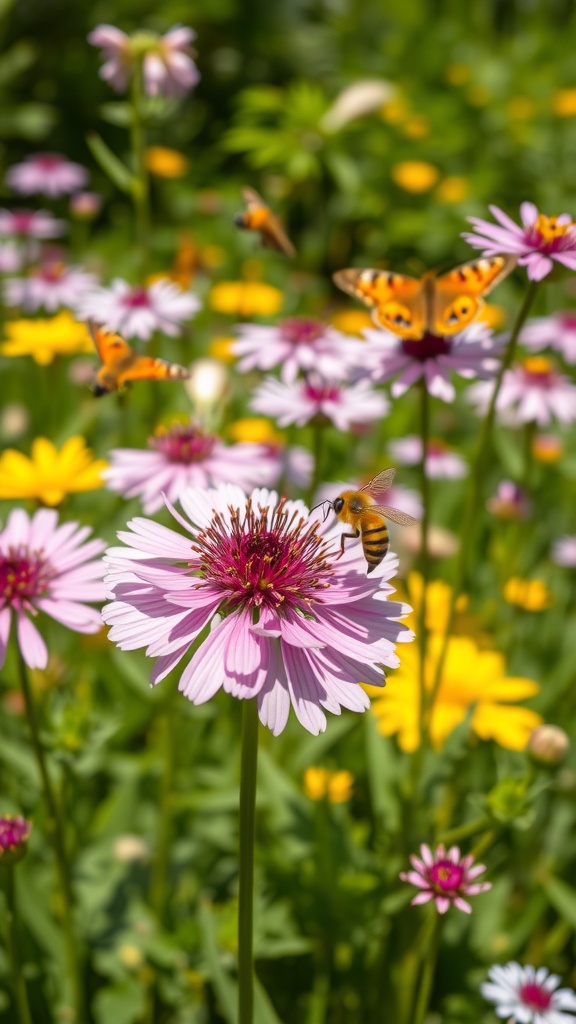
Alliums are not just beautiful; they play a big role in attracting pollinators. These striking flowers, with their round clusters of tiny blooms, are a favorite among bees and butterflies. In the image, you can see a busy bee collecting nectar from a pink flower, surrounded by vibrant yellow and purple blooms. This lively scene showcases how alliums can create a welcoming environment for these important creatures.
When you plant alliums in your garden, you’re not just adding color. You’re also providing a food source for pollinators. Bees, in particular, love the nectar from allium flowers. This helps them thrive and supports the ecosystem. The mix of colors in the garden, like the cheerful yellows and soft pinks, makes it even more attractive to these insects.
Creating a pollinator-friendly garden is simple. Include alliums along with other flowering plants that bloom at different times. This ensures that there’s always something for the bees and butterflies to enjoy. Watching them flutter around your garden can be a delightful experience!
Allium Varieties for Every Garden
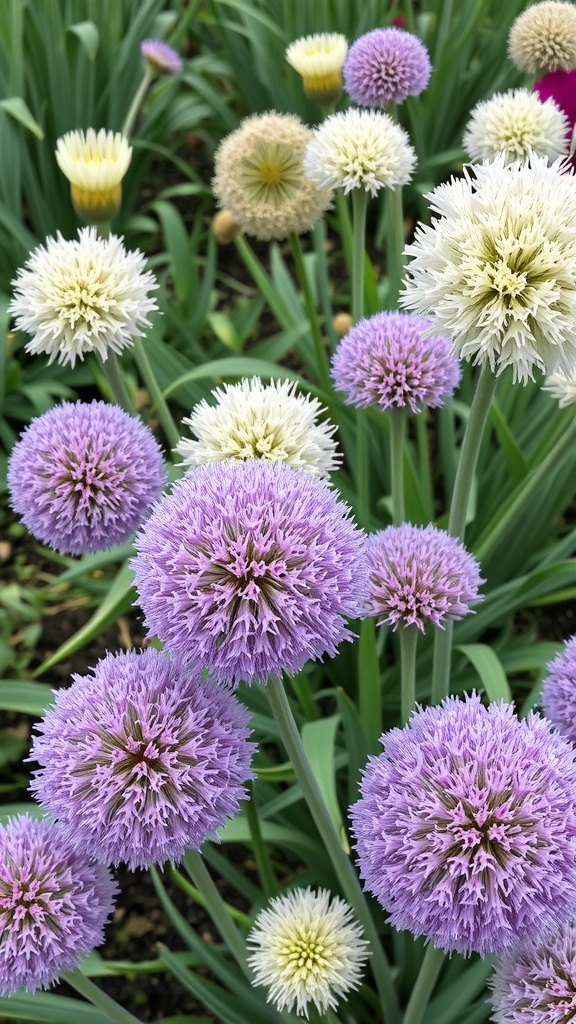
Alliums are a fantastic choice for any garden. Their unique shapes and vibrant colors can really make a space pop. In the image, you can see a lovely mix of allium varieties, showcasing their round, fluffy blooms in shades of purple and white.
These flowers are not just pretty; they also attract pollinators, making them a great addition to any garden. The different heights and colors allow for creative arrangements, whether in borders or as focal points. You can mix them with other perennials or let them stand alone for a striking display.
Some popular allium varieties include Allium giganteum, known for its tall stature and large purple globes, and Allium moly, which offers a more compact form with bright yellow flowers. Each type brings its own charm, ensuring there’s an allium for every garden style.
Alliums in Cottage Gardens
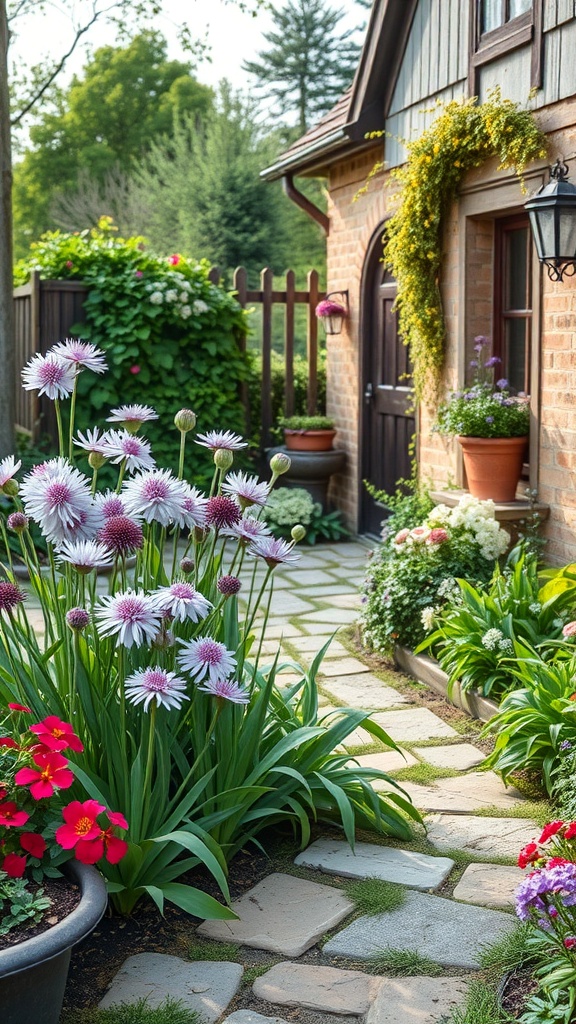
Cottage gardens are known for their charming and relaxed vibe, and alliums fit right in. These tall, striking flowers add a unique touch to any garden. With their round, globe-like blooms, they create a beautiful focal point. In the image, you can see alliums standing proudly among vibrant flowers, enhancing the overall beauty of the space.
The combination of alliums with other colorful plants, like the red flowers in the foreground, brings a delightful contrast. This mix of colors and shapes makes the garden feel alive and inviting. The stone pathway leads you through this lovely scene, encouraging you to explore every corner.
Alliums thrive in sunny spots and are quite easy to care for. They bring a sense of whimsy to cottage gardens, making them a favorite among gardeners. Their tall stems sway gently in the breeze, adding movement and grace to the garden. If you’re looking to create a cozy and colorful outdoor space, consider adding alliums to your plant list!
Dramatic Allium Displays
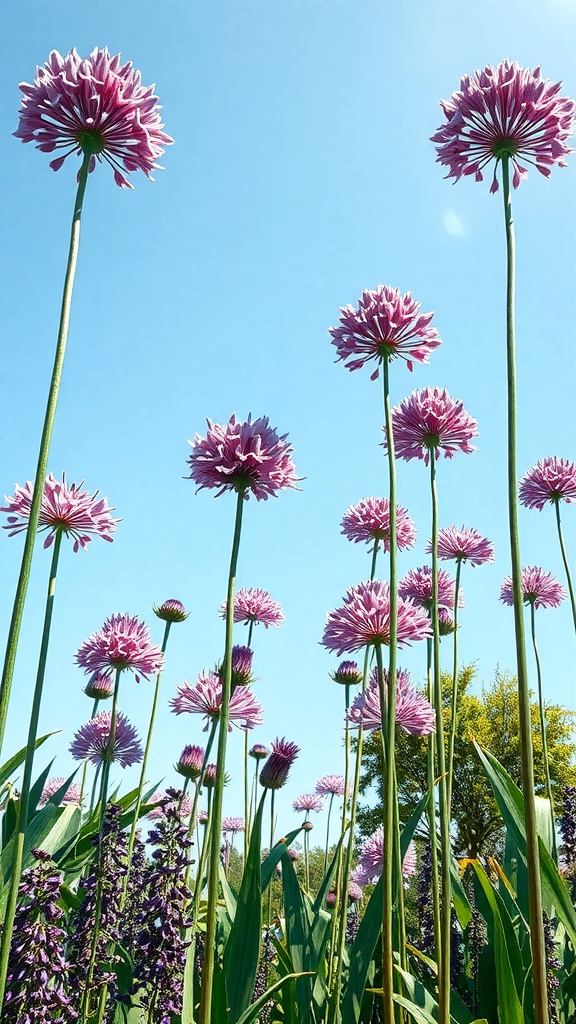
Alliums bring a unique flair to any garden. Their tall stems and round, fluffy flower heads create a striking visual impact. In this image, you can see a stunning display of alliums reaching for the sky, showcasing their vibrant pink hues against a clear blue backdrop.
The height of these flowers makes them perfect for adding drama to garden beds. They stand proudly among other plants, like the deep purple flowers seen here, creating a beautiful contrast. This combination not only enhances the garden’s aesthetic but also attracts pollinators, making it lively and vibrant.
Planting alliums in clusters can amplify their dramatic effect. When they bloom, they create a sea of color that can be enjoyed from various angles. Whether in a formal garden or a casual landscape, alliums are sure to turn heads and spark conversations.
Alliums in Modern Landscape Architecture
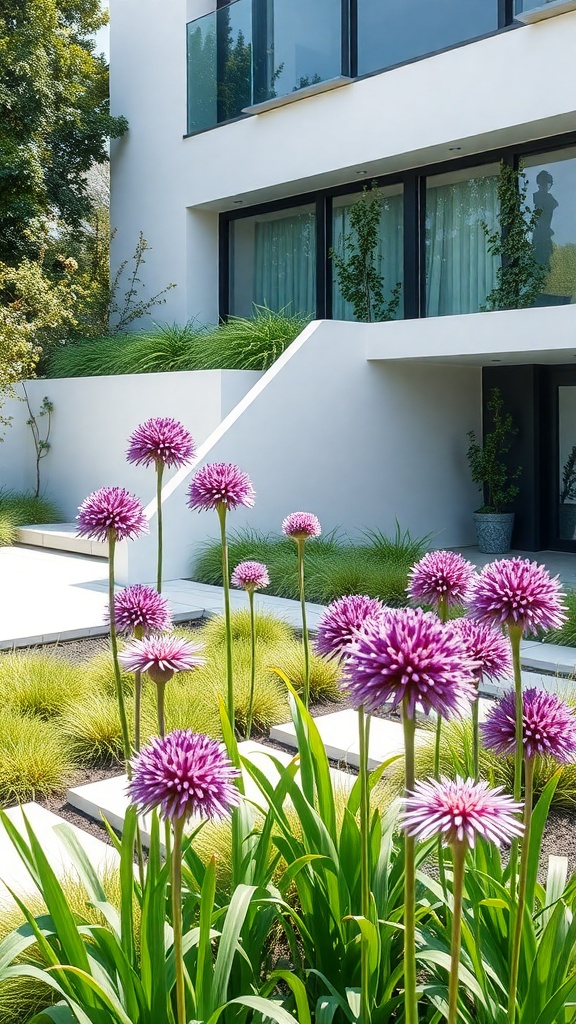
Alliums are making a splash in modern landscape design. These unique flowers, with their round, spiky blooms, add a playful touch to any garden. In the image, you can see vibrant purple alliums standing tall against a sleek, contemporary building. Their bold color contrasts beautifully with the clean lines of the architecture.
The arrangement of the alliums creates a sense of rhythm in the garden. They are planted among lush green grasses, which softens the overall look. This combination of textures and colors draws the eye and invites exploration. The stepping stones leading up to the building enhance the flow, making the garden feel welcoming.
Using alliums in landscaping is not just about aesthetics. They are also low-maintenance and attract pollinators, making them a smart choice for eco-friendly designs. Their unique shape and color can serve as focal points or accents, depending on how they are used.
Alliums and Their Fragrant Companions
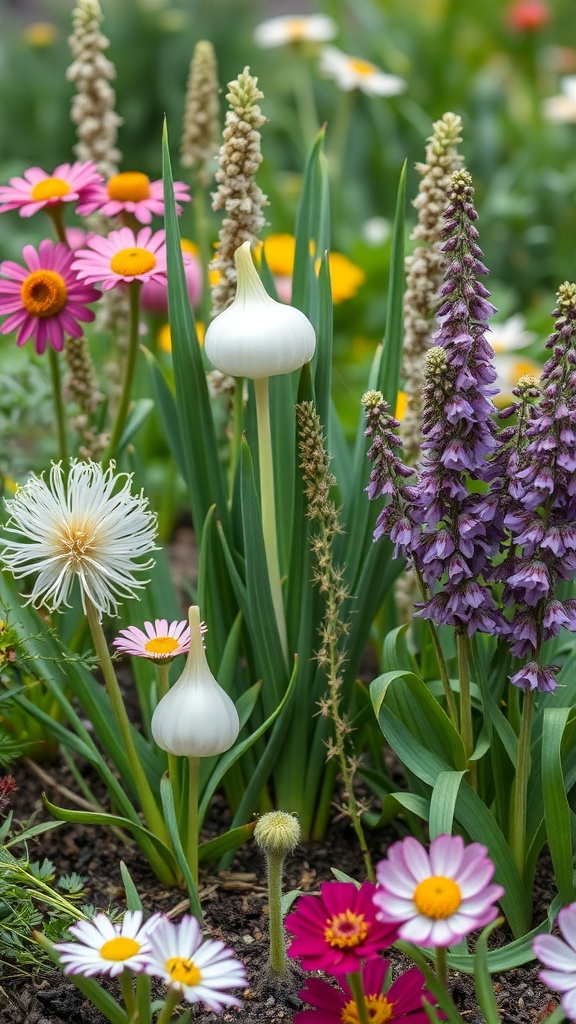
Alliums are a delightful addition to any garden, bringing a unique charm with their distinctive shapes and lovely scents. In the image, you can see a variety of alliums standing tall among a colorful mix of flowers. The white and purple blooms create a stunning contrast against the vibrant pinks and yellows of the surrounding flowers.
These plants not only look great but also attract beneficial pollinators like bees and butterflies. Pairing alliums with other fragrant flowers can enhance the overall experience in your garden. For instance, the daisies and other blooms in the image complement the alliums beautifully, creating a lively and inviting atmosphere.
When planting alliums, consider their companions. Flowers like lavender or echinacea can thrive alongside them, adding layers of color and fragrance. This combination not only pleases the eye but also creates a sensory delight that makes spending time in your garden even more enjoyable.
Low-Maintenance Allium Gardens
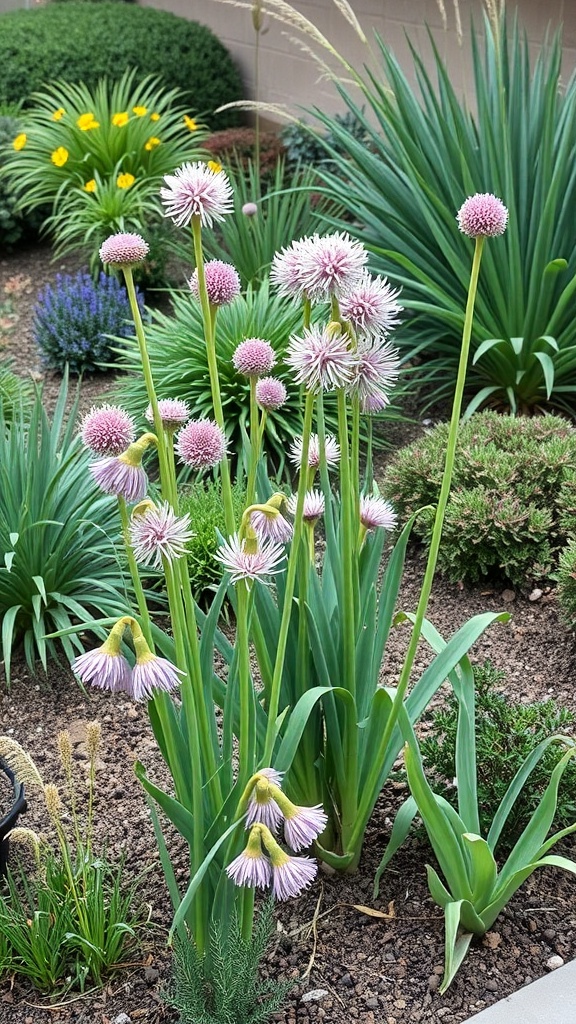
Alliums are a fantastic choice for a low-maintenance garden. These unique flowers bring a pop of color and texture without demanding too much attention. In the image, you can see a vibrant display of alliums surrounded by various green plants. Their tall stems and round, fluffy blooms create a striking visual.
One of the best things about alliums is their ability to thrive with minimal care. They are drought-resistant and can grow in a range of soil types. This makes them perfect for busy gardeners or those who prefer a more relaxed approach to gardening.
The alliums in the picture show different stages of blooming, adding interest to the garden. Pairing them with other hardy plants, like the yellow flowers and lush green foliage seen here, enhances their beauty and creates a lively atmosphere.
Consider planting alliums in clusters for a bold statement. They can also attract pollinators, making your garden not just beautiful but beneficial too. With alliums, you can enjoy a stunning garden that requires little effort to maintain.
Alliums for Drought-Tolerant Gardens
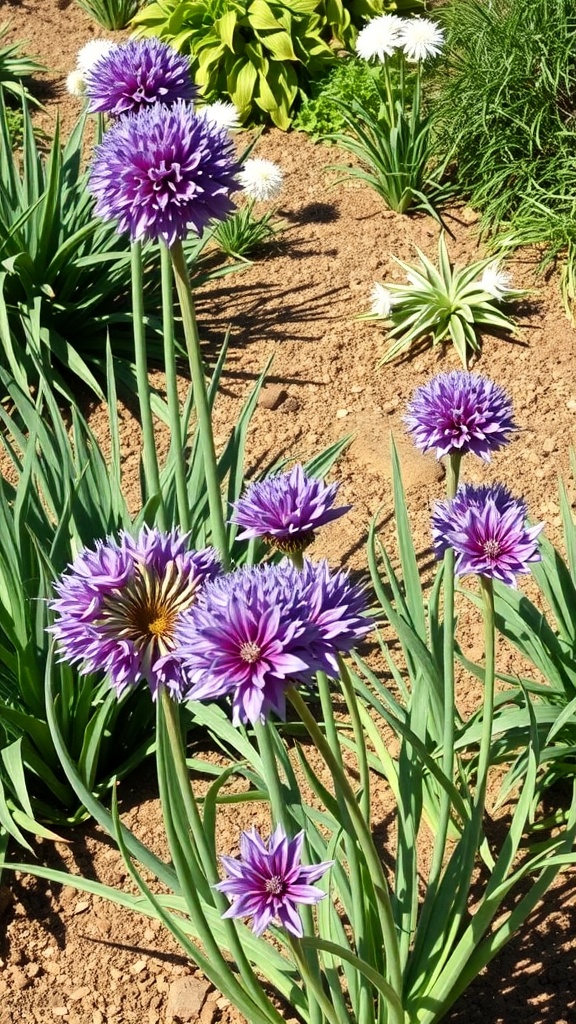
Alliums are a fantastic choice for drought-tolerant gardens. These striking flowers, with their vibrant purple hues, add a pop of color and interest to any landscape. The image shows a cluster of alliums standing tall, showcasing their unique round flower heads. They thrive in sunny spots and require minimal water once established.
These plants are not just pretty; they are also hardy. Alliums can survive in dry conditions, making them perfect for gardens where water conservation is key. Their long, slender leaves complement their bold blooms, creating a beautiful contrast in any garden bed.
Incorporating alliums into your garden design can enhance its overall appeal. They work well with other drought-resistant plants, creating a lively and colorful display. Plus, they attract pollinators, which is a bonus for any garden enthusiast.
Alliums in Urban Gardens

Urban gardens can be a breath of fresh air in the concrete jungle. In this image, we see a rooftop garden filled with vibrant alliums and other greenery. These flowers add a pop of color against the backdrop of tall buildings.
Alliums are perfect for urban settings. They thrive in smaller spaces and bring a unique charm. Their round flower heads create a playful contrast with the straight lines of city architecture.
This rooftop garden showcases how even limited spaces can be transformed into lush retreats. The mix of alliums with other plants creates a lively atmosphere. It’s a great example of how city dwellers can enjoy nature right at their doorstep.
Having alliums in urban gardens not only beautifies the space but also attracts pollinators. Bees and butterflies love these flowers, making them a great choice for anyone looking to support local wildlife.
Alliums for Cutting Gardens
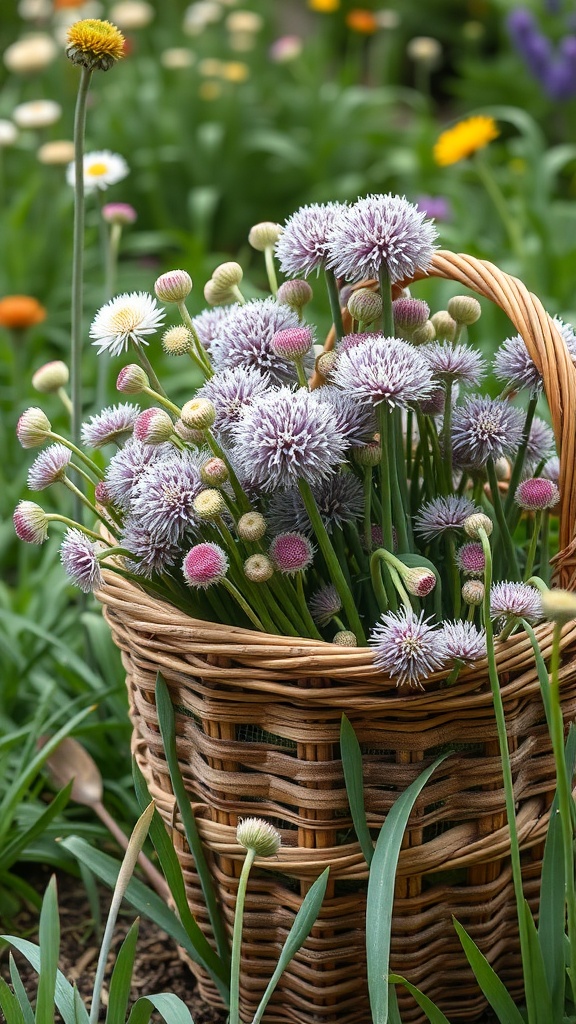
Alliums bring a unique charm to cutting gardens. Their round, fluffy blooms add a playful touch to any bouquet. In the image, a basket brimming with alliums showcases their lovely purple hues, surrounded by a vibrant backdrop of other flowers.
These flowers are not just pretty; they are also hardy. They can last a long time in a vase, making them a favorite for floral arrangements. The variety of sizes and colors allows for creativity when putting together a bouquet.
When planning your cutting garden, consider planting alliums alongside other flowers. They pair well with daisies and other colorful blooms. This mix creates a stunning visual effect and ensures you have a diverse selection for cutting.
Harvesting alliums is simple. Cut them in the morning when the blooms are still closed for the longest vase life. With their unique shape and color, alliums will surely make your cutting garden a delightful space.
Alliums and Garden Art
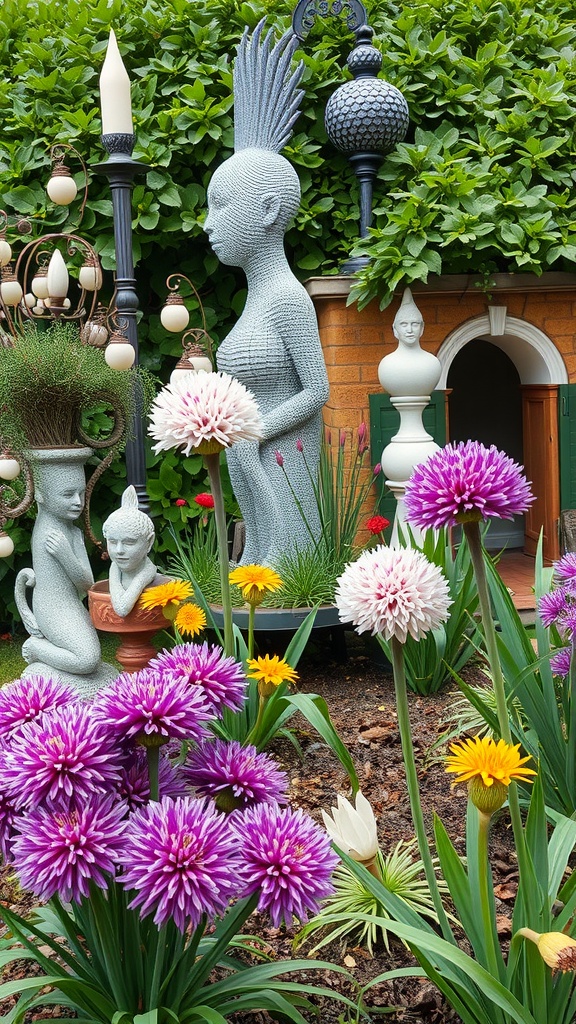
Alliums bring a unique flair to any garden, especially when paired with creative art pieces. In this vibrant scene, you can see a mix of colorful alliums alongside striking sculptures. The bold purple and white blooms stand out beautifully against the lush greenery.
The sculptures add an artistic touch, transforming the garden into a lively space. The figure with a mohawk hairstyle and the playful child figures create a whimsical atmosphere. This combination of flowers and art invites visitors to explore and enjoy the beauty around them.
Alliums are not just pretty; they also attract pollinators, making them a smart choice for any garden. Their round, globe-like flowers add texture and interest, complementing the sculptures perfectly. Together, they create a delightful scene that celebrates both nature and creativity.
Alliums in Wildlife Gardens

Alliums are a fantastic choice for wildlife gardens. Their unique flowers attract a variety of pollinators, making them a great addition to any garden space. In the image, you can see vibrant pink allium flowers standing tall, surrounded by lush green leaves. These flowers not only look stunning but also play a vital role in supporting local wildlife.
Notice how the alliums are blooming alongside other plants, creating a colorful scene. This diversity is key in wildlife gardens, as it provides different habitats and food sources for insects and birds. The bright colors of the alliums can draw in bees and butterflies, which are essential for pollination.
In the image, a small bird is perched on one of the allium flowers. This highlights how these plants can serve as a resting spot for birds, adding life to the garden. By incorporating alliums, you create an inviting environment for various species, contributing to a healthier ecosystem.
Fall Planting of Alliums

Fall is the perfect time to plant alliums. These stunning flowers bring a burst of color to your garden, especially when the leaves start to turn. In the image, you can see someone carefully planting alliums among a carpet of fallen leaves. The vibrant purple blooms stand out beautifully against the earthy tones of autumn.
When planting alliums, it’s important to choose a sunny spot. They thrive in well-drained soil, so make sure to prepare the ground properly. The gardener in the image is using tools to ensure the bulbs are planted at the right depth. This attention to detail helps them grow strong and healthy.
As you plant, think about the layout. Mixing alliums with other fall plants can create a stunning visual effect. The leaves around them add a nice touch, making the garden feel cozy and inviting. Plus, alliums are low-maintenance, so you can enjoy their beauty without too much fuss.
Alliums in Winter Landscapes
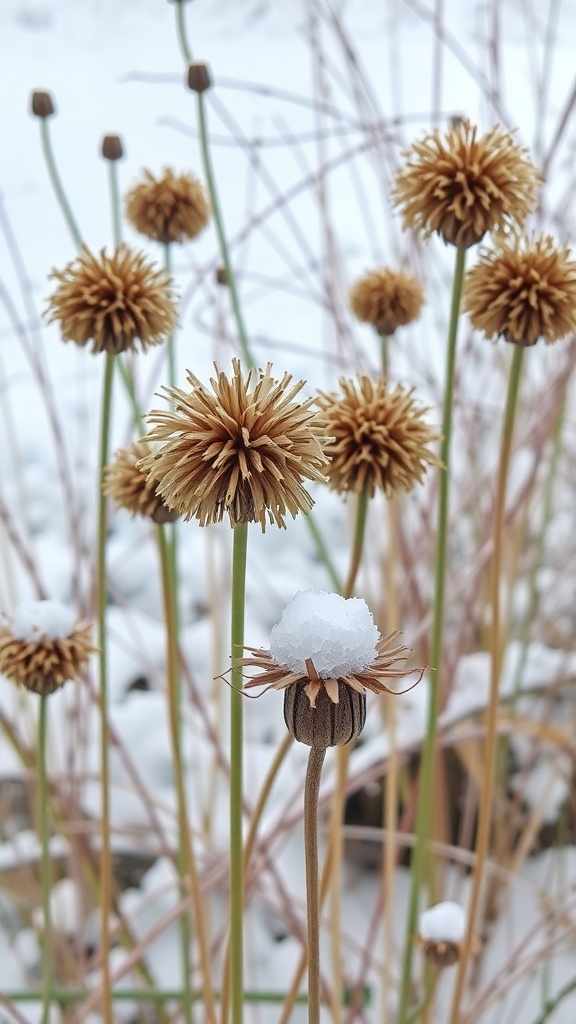
Winter can transform gardens into a serene wonderland, and alliums add a unique charm to this scene. The image shows dried allium heads, standing tall against a snowy backdrop. Their golden-brown hues contrast beautifully with the white snow, creating a striking visual.
These alliums, with their spiky, spherical shapes, retain their structure even in the colder months. The delicate snowflakes resting on top of one allium head add a playful touch, reminding us that beauty can be found in the simplest details of winter.
In winter landscapes, alliums serve as a reminder of the life that once thrived in the garden. They offer texture and interest, even when other plants have gone dormant. This makes them a great choice for winter gardens, providing a focal point that stands out against the starkness of the season.
Alliums for Color Contrast

Alliums are a fantastic choice for adding color contrast to your garden. In the image, you can see tall, striking alliums standing proudly among a vibrant mix of flowers. Their unique spherical blooms create a stunning focal point.
The soft pink and purple hues of the alliums beautifully contrast with the bright yellows and oranges of the surrounding flowers. This combination not only catches the eye but also adds depth to the garden layout.
Alliums are easy to grow and can thrive in various conditions. They bloom in late spring to early summer, making them perfect for extending the color palette of your garden. Pairing them with lower-growing flowers creates a layered look that is visually appealing.
Incorporating alliums into your garden design can elevate the overall aesthetic. They work well with many plants, making them a versatile choice for any flower bed.
Alliums and Garden Pathways
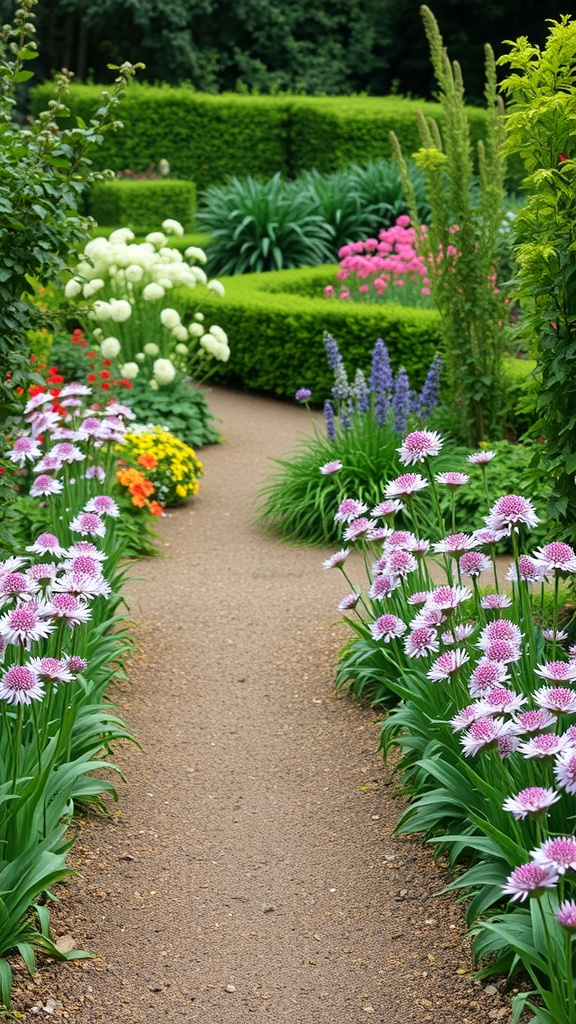
Alliums are a fantastic choice for garden pathways. Their unique shape and vibrant colors add a special touch to any outdoor space. The image shows a lovely pathway lined with alliums, creating a welcoming atmosphere.
As you stroll down the path, the alliums stand tall, their round flower heads drawing the eye. They create a sense of rhythm along the walkway, guiding visitors through the garden. The mix of colors from the alliums and surrounding flowers enhances the beauty of the scene.
Pathways in gardens serve not just as routes but also as a way to connect different areas. With alliums flanking the sides, the journey becomes more enjoyable. Their sturdy stems and hardy nature make them perfect companions for garden paths.
Incorporating alliums into your garden design can transform ordinary pathways into extraordinary experiences. They invite exploration and appreciation of the surrounding beauty. So, if you’re looking to brighten up your garden pathways, consider planting alliums for a delightful touch.
Using Alliums for Vertical Gardening
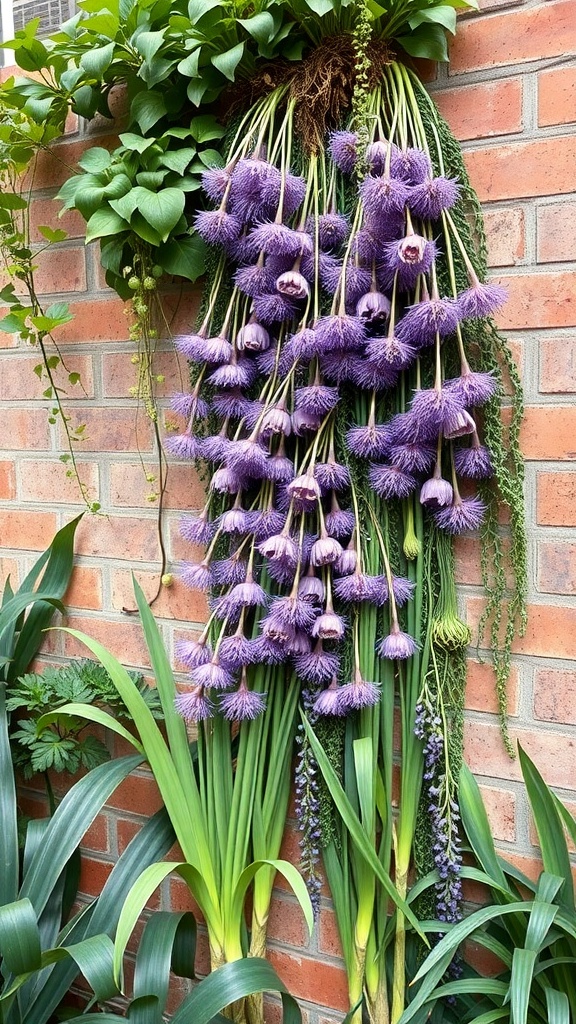
Alliums are a fantastic choice for vertical gardening. Their unique shapes and vibrant colors can really make a space pop. In the image, you can see a stunning display of alliums cascading down a wall. The rich purple hues contrast beautifully with the green foliage surrounding them.
These flowers are not just pretty; they also add height and drama to your garden. When planted vertically, alliums can create a striking focal point. You can mix them with other plants to enhance their beauty. The tall stems and fluffy blooms draw the eye upward, making any garden feel more expansive.
Vertical gardening with alliums is also practical. It saves space and can be done in small areas like balconies or patios. You can use wall planters or trellises to showcase these lovely flowers. Just imagine walking into a garden filled with these vibrant blooms, adding a cheerful touch to your outdoor space.
Alliums in Mediterranean Gardens
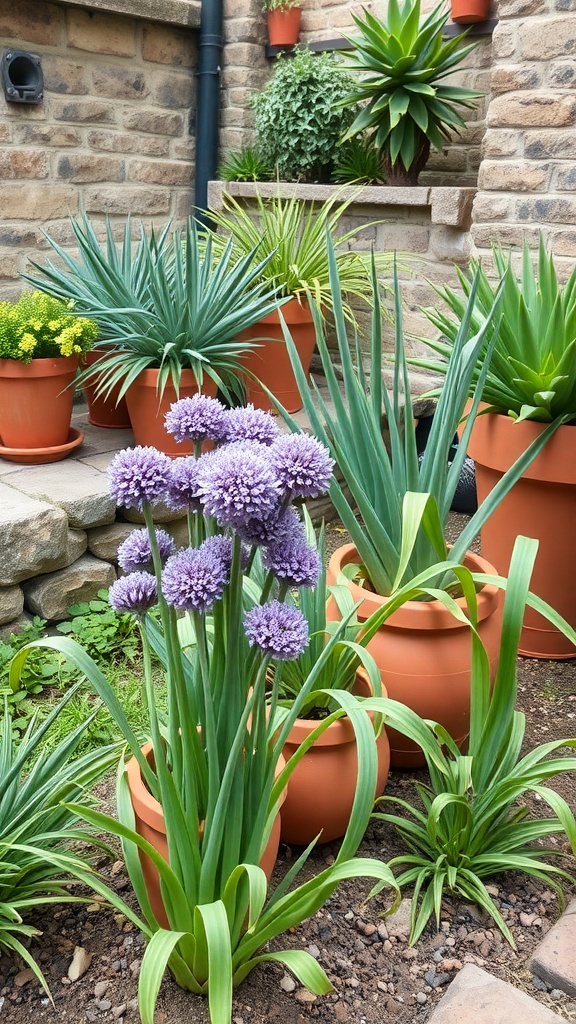
Alliums bring a unique charm to Mediterranean gardens. Their striking purple blooms stand tall among lush greenery, creating a vibrant scene. In the image, you can see alliums nestled in terracotta pots, which is a classic choice for this style of garden.
The combination of alliums with other plants, like succulents and herbs, adds texture and interest. The tall, spiky leaves of the alliums contrast beautifully with the softer foliage of surrounding plants. This mix not only looks great but also attracts pollinators, enhancing the garden’s ecosystem.
In Mediterranean climates, alliums thrive with minimal care. They prefer well-drained soil and plenty of sunlight. This makes them a perfect fit for those looking to create a low-maintenance yet stunning garden. Whether you’re planting them in pots or directly in the ground, alliums can elevate any outdoor space.
Alliums for Night Gardens
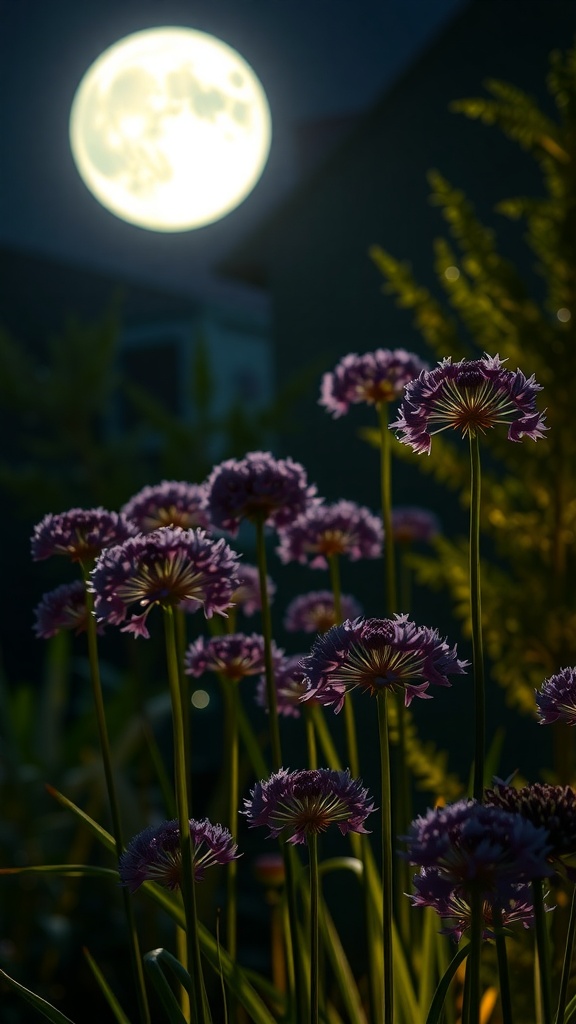
Alliums are a fantastic choice for night gardens. Their tall, slender stems and vibrant purple blooms create a striking silhouette against the night sky. In the image, you can see these beautiful flowers illuminated by the soft glow of the moon. This creates a magical atmosphere that enhances any garden space.
Night gardens are all about creating a serene and enchanting environment. Alliums not only add color but also attract nighttime pollinators. Their unique shape and texture stand out beautifully under moonlight, making them a perfect focal point.
When planning your night garden, consider planting alliums in clusters. This will create a stunning visual impact. Pair them with other night-blooming plants to enhance the overall effect. The combination of scents and colors will make your garden come alive at night.
